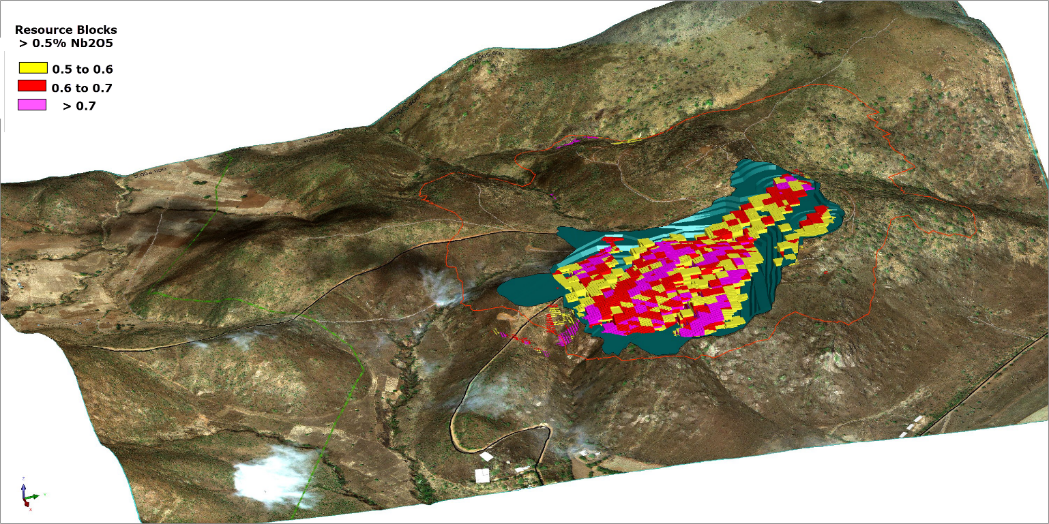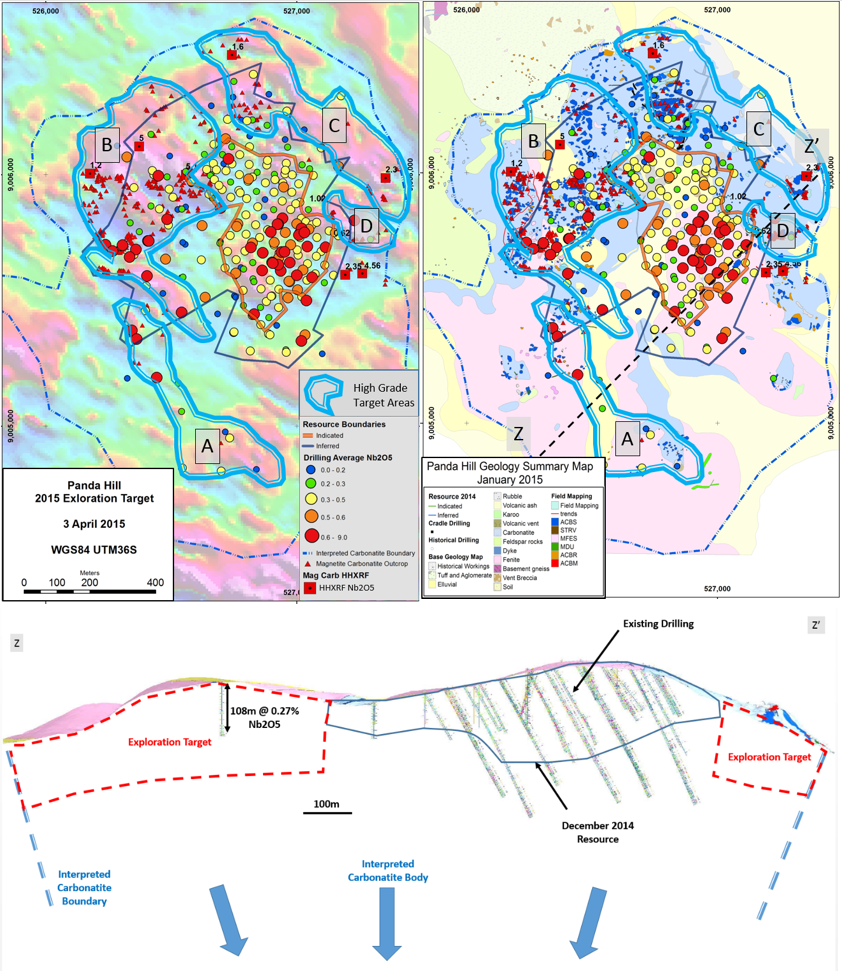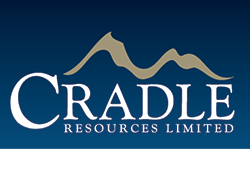Mineral Resource
Cradle announced a major upgrade to the Mineral Resource in April 2015 (Table 1 and Figures 1, 2 and 3) which now stands at 178Mt @ 0.5% Nb2O5. This update occurred after the March PFS announcement and formed the basis of the 2015 Definitive Feasibility Study.
The new Mineral Resource incorporates the results of an additional 9,324m of RC and Diamond drilling that was not included in the December 2014 Mineral Resource update; bringing the total drilling by Cradle used in the resource estimate to 20,142m (98 RC holes and 46 Diamond holes) with an average depth of 148m (max 377m). The resource also included 33 diamond holes for 2389m drilled by previous owners.
The Resource was estimated by Coffey Mining using Multiple Indicator Kriging on 2m composites with a 25m x 25m by 5m (X x Y x Z) panel to generate a recoverable estimate emulating an SMU of 6.25m x 12.5m x 5m. Significantly, this resource is based predominantly on new RC and diamond drilling undertaken by Cradle in 2014, and also incorporates the first Measured resources on the project.
Highlights of the Resource update include:
- The Primary Carbonatite Resource is increased to 167Mt at 0.5% Nb2O5 , representing a 90% increase in tonnage.
- The Measured and Indicated Mineral Resource has increased to 69Mt @ 0.53% Nb2O5, representing a 68% increase in Indicated+ material.
- The new Mineral Resource is based on the Multiple Indicated Kriging (MIK) method which incorporates increased mining selectivity and internal dilution for a planned Selective Mining Unit (SMU).
- Initial mine scheduling will focus on the Angel Zone comprising a higher grade sub-zone of the Indicated Mineral Resource.
| Table 1 Panda Hill 2015 Mineral Resource Reported Above a 0.3% Nb205 Lower Cut-off |
|||
| Combined | |||
| Classification | Million Tonnes | Nb205 % | Nb205 Content (KT) |
| Measured | 16 | 0.63 | 99 |
| Indicated | 53 | 0.50 | 263 |
| Inferred | 109 | 0.48 | 528 |
| Total | 178 | 0.50 | 891 |
| Primary Carbonatite1 | |||
| Classification | Million Tonnes | Nb205 % | Nb205 Content (KT) |
| Measured | 14 | 0.62 | 84 |
| Indicated | 50 | 0.49 | 247 |
| Inferred | 103 | 0.48 | 496 |
| Total | 167 | 0.50 | 828 |
| Weathered Carbonatite2 | |||
| Classification | Million Tonnes | Nb205 % | Nb205 Content (KT) |
| Measured | 2 | 0.67 | 15 |
| Indicated | 3 | 0.53 | 15 |
| Inferred | 6 | 0.52 | 32 |
| Total | 11 | 0.55 | 63 |
| Note: Figures have been rounded. 1 Primary Carbonatite is defined as a region of fresh to Moderately Oxidised material dominated by carbonatite lithologies. This material is expected to have a higher metallurgical recovery. 2 Weathered Carbonatite is a region dominated by strongly oxidised material comprising weathered carbonatite with other mixed lithologies. This material is expected to have a lower recovery than the Primary Carbonatite material. | |||

Figure 1: Geology plan showing the 2015 Resource regions. The regions in blue (carbonatite) and pink (Fenite Cap) are both highly prospective with field mapping showing carbonatite and magnetite-carbonatite outcrop contained with many of these areas.

Figure 2: Cross-section (K) showing block model grade (above 0.3% SMU), drillhole grade bars and resource classification.

Figure 3: Schematic of First 5 Year Pit Design (green) with the LOM outline (red outline) and Mineral Resource blocks
Exploration Target
There is also an Exploration Target* on the Project (Figure 4) of between 200 and 400 million tonnes with a target grade of between 0.4% and 0.6% Nb2O5 which was announced 23 April 2015. Over the region of the carbonatite that falls outside of the current Mineral Resource, four potential high-grade target zones have been identified which will be the focus for future exploration efforts.
The target was based upon the area of the mapped carbonatite boundary outside of the current resource area (Figures 4 and 5). The depth extent of the Exploration Target is approximately 200m (see Figure 4 for an example section) and a conservative density of 2.5t/m3; additionally this volume has been reduced by 50% for reporting purposes. The Exploration Target includes both weathered and primary mineralisation types.
The grade profile for the Exploration Target was defined based upon average grades of historical drilling and pitting in the region, combined with an assessment of the grade profile of Cradle drilling in 2013 and 2014. It is noted that in general Cradle drilling often exceeded the tenor of the comparable historical holes.
^JORC Note on Exploration Target
The Exploration Target is conceptual in nature as there has been insufficient exploration to define a Mineral Resource. It is uncertain if further exploration will result in the determination of a Mineral Resource under the “Australasian Code for Reporting of Exploration Results, Mineral Resources and Ore Reserves, the JORC Code” (JORC 2004). The Exploration Target is not being reported as part of any Mineral Resource or Ore Reserve

Figure 4: Top: The Exploration Target is contained within the boundary of the carbonatite and outside of the shadow of the current resources. Target regions for potential high-grade mineralisation identified from a combination of mapping, drilling and air-borne magnetic data. The first derivative magnetic data (left hand side) shows magnetic trends that have a high correlation to mapped mineralised magnetite-carbonatite outcrop (right hand side). Both images show average drill hole grade or pitting (circles), mapped magnetite carbonatite exposure (red triangles), magnetite carbonatite handheld XRF samples (HHXRF – red squares – % Nb2O5). Bottom: Example cross section (Z-Z’) showing the region of the exploration target with a nominal 200m depth.

Figure 5: Typical examples of outcrop in the priority target areas identified. First Image: Sovite and magnetite-rich carbonatite outcrop in region C. Second Image: Magnetite carbonatite from Region B – this sample tested 5% Nb2O5 from the hand-held XRF unit. Third Image: Carbonatite showing flow banding and magnetite-rich bands from Region D. Last Image: Carbonatite outcrop in region C.
Competent Person’s Statement
The information in this document that relates to Exploration Results and Resources is based on information compiled or reviewed by Mr Neil Inwood who is a Fellow of The Australasian Institute of Mining and Metallurgy and a Member of the Australian Institute of Geoscientists. Mr Inwood is a full time employee of Verona. Mr Inwood has sufficient experience which is relevant to the style of mineralisation and type of deposit under consideration and to the activity which he is undertaking to qualify as a Competent Person as defined in the 2004 Edition of the ‘Australasian Code for Reporting of Exploration Results, Mineral Resources and Ore Reserves’. Mr Inwood consents to the inclusion in this document of the matters based on his information in the form and context in which it appears.

